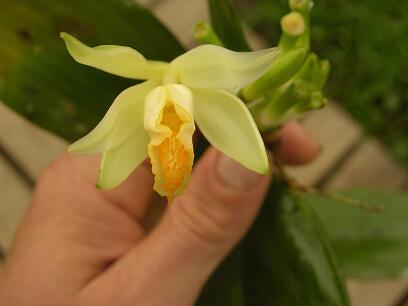Orchidaceae
Vanilla cristato-callosa Hoehne

Kingdom: Plantae Rank: Species Parent: Vanilla Status: Valid
Vegetative Morphology
Habit: Plant a short understory vine climbing to 4 meters. Climbs via aerial roots produced from each node, white, unbranched. Terrestrial roots emerging from lower stems and entering superficially into substrate, branched and extensive.
Main axis: Stems succulent, 0.6 – 0.9 cm in diameter, internodes ca. 6cm for climbing individuals.
Leaves: Leaves alternate, succulent, sessile, borne opposite to aerial roots, held horizontal to ground, ca 3 X 9.5 cm – 7 X 17 cm; blade elliptic, apex acute to slightly acuminate, margin entire, texture smooth.
Reproductive Morphology
Inflorescence: Inflorescences racemose, terminal or axillary, fleshy, green, sessile, ca 1 to 40-flowered; bracts green, triangular.
Flowers: Flowers resupinate, tender, fleshy, arranged spirally, fragrance fabacious like torn leaf of a bean; pedicel white for half its length and fading to green apically, with ovary, ca 0.4 cm wide, 4.9 cm long; buds green; sepals yellow, oblanceolate, apex acute, ca 0.9 x 6.3 cm; petals yellow, oblanceolate, apex acute, 0.8 x 5.6 cm; lip yellow, ca 5.5 cm long, fused with column for 4 cm dorsally, patch of warty papillae ca 0.6 x 1 cm dominates lip surface; callus ca 0.4 x 0.3 cm; column 4.6 cm long, 0.2 cm wide; anther cap yellow, 0.2 x 0.4 cm.
Fruit: Fruit fleshy, cylindrical in cross-section, green when immature, approximately 1 x 15cm, mature dehiscent fruit produces abundant gelatinous substance, strong vanillin fragrance.
Other
Ecology:
Only two fertile collections possessing flowers are known and they are both from the Peruviain Amazon (Soto Arenas, pers com). In our region V. cristatocallosa occurs in M. flexuosa wetlands characterized by deep histosols where it exhibits a patchy distribution, occurring in small populations within localized areas. Generally, the species is more tolerant of lower light conditions than other local Vanilla species.
Flowering occurs in mid-Jan to Apr, during the height of the rainy season. In agricultural settings of a plantation where resource limitations are reduced a vine may produce flowers all year long. If this is the case, the terminal racemes prevent upward growth and the vine remains vertically stunted. Ephemeral flowers open singly .over an interval of two to four days. Pollination rates are approximately 6% (Table 1). The pollinator is unknown. Fruits of reproductive individuals in their natural habitat often occupy a terminal position on the inflorescence, suggesting that once pollinated, continued flower production ceases. Fruits mature in approximately six months. Dehiscent fruits are oily with a strong vanilla aroma, somewhat spicy and cinnamon-like. We observed several individuals of a single species of metallic green Euglossa sp. visiting old fruits demonstrating typical fragrance collection behavior (Roubik 1989). The species exhibits a degree of myrmecology, as ants that feed on a sugary exudates secreted at the abscission line between bud and ovary are often present during bud and raceme development.
Notes: An obscure and little known complex, probably synonymous with V. cristagallii Hoehne. Hoehne proposed several names, but the drawings and type specimens are not useful (Soto Arenas, pers. comm.). These represent a diverse group of poorly collected Amazonian species and field work is necessary to resolve species concepts. Nonetheless, we can group this as a member of the American clade of fragrant Vanilla.